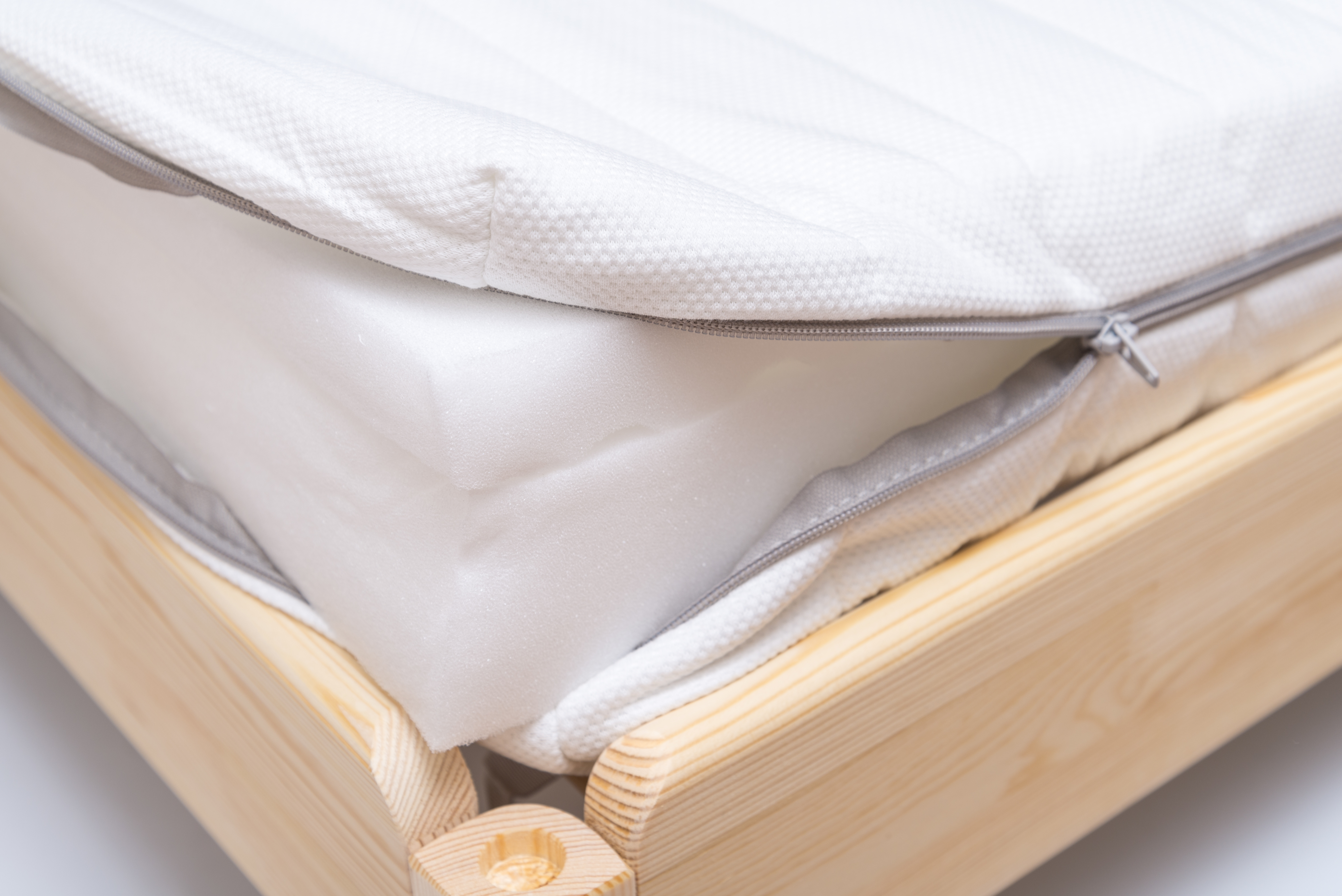Recent Posts
- Home
- Blog | Vancouver Mattress Store
- How Long Does A Memory Foam Mattress Last
How Long Does A Memory Foam Mattress Last
Posted by on

A new mattress is a big decision. Today, you have the option of choosing between traditional and modern mattress types. But with whatever you choose, you shouldn’t compromise when it comes to your comfort.
A very popular kind of non-traditional mattress is a memory foam mattress. These have become increasingly popular over the last decade. They are different from traditional spring mattresses and use memory foam technology to provide maximum comfort.
But what is a memory foam mattress? How long does a memory foam mattress last? And, is there anything you can do to make them last longer?
Related article: Ultimate Buying Guide on Memory Foam Mattress
The origin of memory foam
Memory foam is a polyurethane material. It is used in mattresses because it is sensitive to pressure and temperature. This allows it to mould to the shape of the individual’s body to provide optimum comfort and support.
Interestingly, the original reason for inventing memory is nowhere connected to the mattress and sleep industry. It is a product of the National Aeronautics and Space Administration (NASA), who enjoyed exclusive use of the material until its release into the public domain.
In the 1960s, NASA contracted with the Stencel Aero Engineering Cooperation for the invention of this revolutionary foam. This collaboration was aimed at finding solutions to a few problems faced by astronauts during space travel.
Astronauts experience extreme gravitational forces (g-forces) while entering and exiting the Earth’s atmosphere. These g-forces put a heavy strain on the body. This meant that the scientists at NASA needed to find a way to relieve the pressure. Memory foam was the material that was designed as a result.
The seats in the space shuttle were also quite uncomfortable. Hence there was a need for better cushioning on the aircraft. Memory foam was the ideal material that could guarantee optimal comfort for the long duration of space travel. The foam could also adapt to different bodies. This meant there was no need to modify the seats to fit each individual astronaut.
NASA released memory foam to the public in the early 1980s. The first company that attempted to harness its potential for commercial use was Tempur-Pedic ®. They created their own version of memory foam called Tempur ®. Due to its pressure relieving properties, it initially found use in medical settings. It was also used in sports equipment, especially as cushioning in helmets.
In 1991, the Tempur-Pedic Swedish Mattress was born. This was the first time that memory foam was used in a mattress. It became an instant success among the people of Sweden. Memory foam mattresses also received a similar response when released in other countries. This marked a revolution in the sleep industry.
Understanding memory foam technology
After years of improving and developing the product, memory foam has become one of the best pillow and mattress materials in the world. It is the only kind of mattress that can conform perfectly to the shape of the body and still regain its original shape.
The base material used in a memory foam mattress is polyurethane. Specialized chemicals are added to increase viscosity and density. These give it a slightly semi-fluid consistency. It is often referred to as "viscoelastic" polyurethane foam, or low-resilience polyurethane foam (LRPu).
The chemical structure of memory foam is quite unique. Open foam bubbles create a matrix through which air can move. This allows it to change to accommodate the body shape, while still being able to spring back to the original form once the pressure is removed.
Memory foam is also heat sensitive. It absorbs the heat from the body to soften and compress itself around the contours of the body. Once cooled, it regains its firmness. The heat absorbing nature of memory foam can cause it to feel excessively warm, especially in hot weather.
However, advances in the technology used in these mattresses have remedied this problem. A new kind of mattress that uses an open-cell structure was developed. This improved breathability by channelling out the body heat. These are widely known as ‘Air Cool’ memory foam mattresses. They absorb less heat for a cooler night’s sleep.
In 2006, ‘Gel’ memory foam was introduced. This is the latest in memory foam technology. Gel mattresses contain gel particles infused with the foam. These prove more effective at reducing pressure than traditional memory foam. The gel also retains less heat.
New innovations have resulted in the addition of other materials to the original memory foam base. Substances are often combined with the foam to reduce odours and also provide an added benefit of aromatherapy. These could include, aloe vera, green tea, activated charcoal, etc.
Related article:What is a Gel Memory Foam Mattress?
How long does a memory foam mattress last?
Depending on how well they are cared for, a memory foam mattress can last anywhere between 5 to 10 years. There are three major indicators of the longevity of a memory foam mattress. They are the foam density, the support base (the core) and warranties.
Foam density
Density plays a significant role in determining the quality, durability and even comfort level of a memory foam mattress. Simply put, density is the firmness of the mattress. It is expressed in pounds per cubic foot. For example, if it is said that the foam density of a mattress is 3 pounds per cubic foot, it means that every foot of foam weighs 3 pounds.
A memory foam mattress can have either a high, medium or low-density rating. Low-density foams range between 2 and 4 pounds per cubic foot. Memory foam with a density of 4 to 5 pounds per cubic foot is medium-density foam. Anything weighing more than 5 pounds per cubic foot is high-density memory foam.
Higher density means that there are more cells in an area than there would be in the same size area of a medium or low-density foam. Since there are more cells to support and distribute the weight, lesser compression takes place. Lesser the compression, longer the lifespan. In lower density foams compression takes place after repeated use. This means that they have a slightly shorter life.
On average, low-density foam mattresses can last up to 5 years. Medium and high-density foams can last anywhere between 8 to 10 years. But again, this would depend on the amount of use and the level of care and maintenance.
Typically, all memory foam mattresses have the same basic chemical composition. However, the different levels of firmness and thickness can make them feel quite different. Although the higher density foams are longer lasting, these might not be the best choice in terms of comfort. Since these have more tightly spaced cell structures, they may tend to feel quite firm. On the other hand, medium density foams provide optimum comfort while still maintaining their durability.
Support base
Beneath the actual memory foam layer of a mattress lies the support base or core. This is the supporting structure of the mattress and actually bears the body weight. It compliments the upper layer of memory foam. The quality of the core directly affects the longevity of a mattress.
Higher the density of the core, the higher the resilience. A good quality core usually has a density of 2.0 - 2.5 pounds per cubic foot. Mattresses within this range provide good support and last longer. Anything lower than 2.0 pounds per cubic foot will soften, compress and break down much quicker. Thus a low core density shortens the lifespan of a memory foam mattress.
It is important to remember that a low-quality support base will decrease the lifespan of even a high-quality foam layer. This makes high resilience cores the best choice in any memory foam mattress.
Warranties
Like we’ve mentioned earlier, a memory foam mattress can last up to 10 years on average. So a good quality foam should come with a coverage of 10 years. The warranties should also cover the main issues of sagging and compression over time.
Related article: How to Choose the Right Mattress
How can you make a memory foam mattress last longer?
Choose a good quality product
To ensure you get the longest use out of your mattress, the first step is to check its quality. Review the brand and find out where the product was made. Today, the US, Canada, and China are the most trusted manufacturers of memory foam mattresses. Examine the product and look out for any signs that it might be previously used or a knock-off. Reading reviews and customer testimonials will also help you assess the product before you decide to invest in it.
Build a strong base
A weak foundation will cause the mattress to sag quicker. To prevent sagging and extend its lifetime, place the mattress on a solid and supportive base. Moreover, the mattress will contour around any breaks or defects of your old base. So make sure your bed is fixed and in good condition.
Use a mattress cover
Liquids are very damaging to memory foam. There is a reaction caused when the chemicals in the mattress come into contact with these kinds of substances. A mattress that is protected from hazardous substances will last longer. Waterproof covers are the best choice as they prevent contact of the foam with all kinds of liquids. Padded mattress covers can also be used to prevents dents from forming over time.
Carry out routine maintenance
You can get more years out of your mattress by just looking after it. Proper care and maintenance can go a long way in increasing its longevity. Although memory foam mattresses don’t need to be flipped as regularly as traditional mattresses, they do benefit from this. Flipping the mattress every few months will help it to even out the wear and regain its shape.
Follow proper cleaning techniques
Cleaning is essential to keep the mattress in pristine condition. But water can be very damaging to memory foam. To keep contact with moisture to a minimum, use a slightly damp sponge or cloth to clean up spills and stains. Avoid using strong soaps and detergents as these could corrode the foam layers. Use a mild soap that will not react with the material. Also, do not use heat to dry the mattress, allow it to air dry on its own.
Here are a few benefits of using a memory foam mattress-
Longer lifespan
An advantage of choosing memory foam mattresses is their longer lifespan. Like we’ve mentioned earlier, memory foam is made up of a material that is of higher density and durability. The obvious consequence would be that memory foam mattresses are long lasting. They can be used for up to 5 years longer than traditional spring mattresses.
Reduces pressure points for pain relief
Uneven weight distribution while sleeping leads to the buildup of pressure points all over the body. This results in bodily aches and pains. However, a memory foam mattress evenly redistributes body weight to reduce pressure on the heaviest parts of the body. Blood circulation is also improved. This helps in reducing pains from old injuries and in preventing new ones.
Promotes proper spine alignment
A characteristic unique to memory foam is its ability to contour to the shape of the body. The material adapts to caress every curve of the body. This is especially important for the back and spine areas. By supporting the lower back while keeping the spine in a neutral position, it ensures that the back and spine are properly aligned. This can also promote the healing of injuries to these areas.
Provides resistance to motion transfer
Memory foam absorbs surface movement to reduce disturbances to a minimal. As the mattress conforms to each individual body, a personal ‘sleep zone’ is created. This eliminates the feeling of any disturbance felt from a partner tossing and turning on the same bed.
Resistant to dust mites and allergens
After a few years of use, a typical mattress can accumulate up to 10 million dust mites and allergens. However, this is not the case with memory foam mattresses. The fibres in the foam structure are so densely packed that they cannot be penetrated by these microbes. This makes memory foam mattresses hypoallergenic and ideal for people who are prone to allergies.
Related article: Can memory foam mattress cause back pain?
 Loading... Please wait...
Loading... Please wait...


